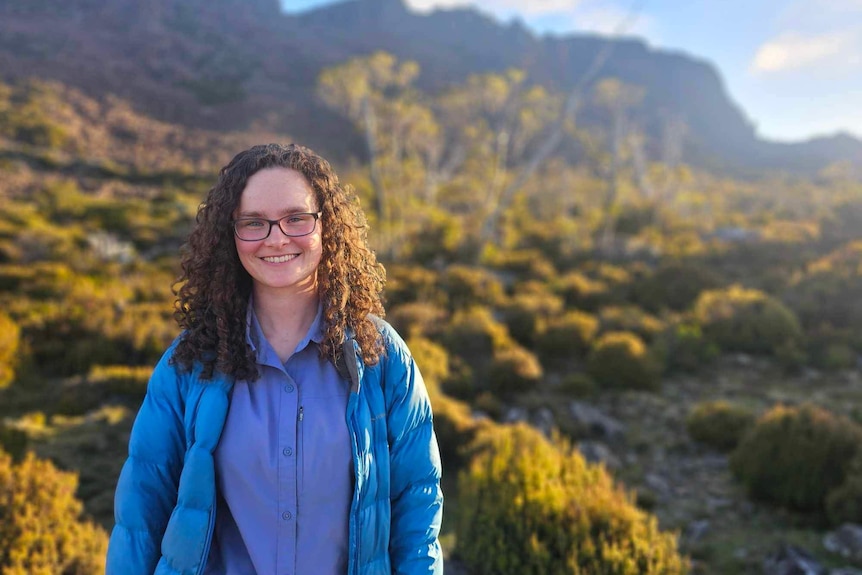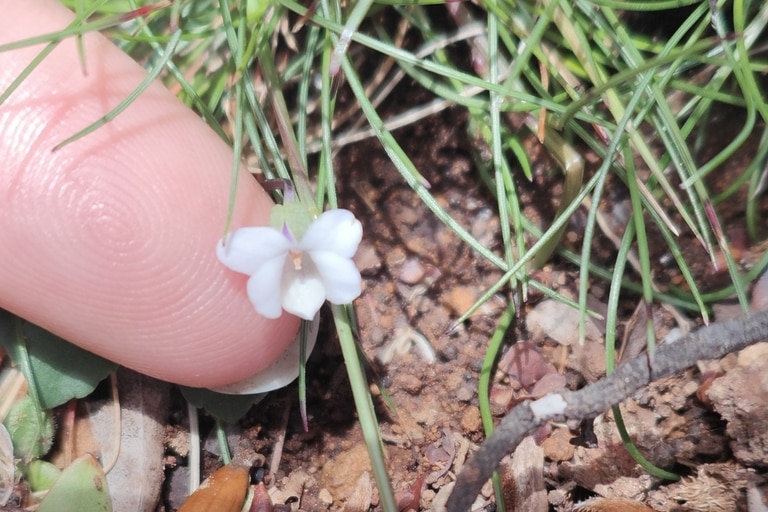This native violet was found by Juliette Gaynor-Brown on the side of a walking track.(Supplied: Matthew Baker)
Juliette Gaynor-Brown was out walking in Tasmania's Ben Lomond National Park when she came across a small purple flower on the side of the track.
"I take photos of everything because I like plants," Ms Gaynor-Brown said.
Ms Gaynor-Brown is a member of the Tasmanian Rovers and was staying in one of the park's mountain huts last month when she went for a walk up to the plateau with some friends.
"On the way back down I saw it, and I knew it was violet but I didn't know what species it was," she said.
She took a photo and uploaded it to citizen scientist platform iNaturalist, where it caught the attention of experts.
It turned out the dwarf violet had never been recorded in Tasmania and was an endangered species found only in a handful of places in eastern Victoria and south-eastern New South Wales
.
Juliette Gaynor-Brown was out walking in Ben Lomond National Park when she came across the violet.(Supplied: Juliette Gaynor-Brown)
Juliette Gaynor-Brown was out walking in Ben Lomond National Park when she came across the violet.(Supplied: Juliette Gaynor-Brown)
A 'lucky break'
Serendipitously, two of Australia's violet experts happened to be in Tasmania at the same time over the Christmas holidays, and went to the site of the discovery to take samples and confirm the species.
One of the experts, senior curator of botany with the Tasmanian Museum and Art Gallery Miguel de Salas, said it was a lucky break.
The violets were growing on the side of a walking track.(Supplied: Miguel de Salas)
"I saw this funny violet come through as an observation over the Christmas break, so I left a message for the user," he said.
Ms Gaynor-Brown was able to return to the spot to take additional photos for the experts to look at, who decided it was a special find.
"We both went up and had a look and found it is a new record Tasmania, it has never been seen here before," Dr de Salas said.
"It is a super rare violet called the dwarf violet, Viola improcera.
"It's only known in very few populations so it's a massive range extension and a really healthy population which is great news. It's a pretty exciting discovery."
Dr Miguel de Salas in the Tasmanian Herbarium, which houses 300,000 specimens.
(ABC Radio Hobart: Georgie Burgess)
'Hiding for 200 years'
Dr de Salas said the species was quite small and inconspicuous, and liked growing in areas where there had been human disturbance.
"It's been hiding for 200 years right next to a walking track, which shows you how well it hides," he said
.
The small violet is only found in a handful of other places on mainland Australia.(Supplied: Juliette Gaynor-Brown/iNaturalist)
"They like to grow on bare ground, and they like to spread onto disturbed ground.
"The ability to grow on the side of a track is what got it noticed in the first place."
He and his colleague got permits and collected samples of it earlier this month.
The samples were put in a plant press to dry out before being studied.
They will then be mounted and stored in the state's herbarium with 300,000 other specimens, and duplicates will also be sent to herbariums in other states.
It will be added to the state's list of threatened species and data Australia-wide will be updated to reflect that it is now found in Tasmania — including the chapter on violets in Flora of Tasmania.
"It also means we get a beautiful new plant which happens to be endangered so it's great news for its conservation," he said.
"It's important to spread the word because we currently know it from a single population, it may be more widespread and it's just never been noticed."
The small violet is only found in a handful of other places on mainland Australia.(Supplied: Juliette Gaynor-Brown/iNaturalist)
"They like to grow on bare ground, and they like to spread onto disturbed ground.
"The ability to grow on the side of a track is what got it noticed in the first place."
He and his colleague got permits and collected samples of it earlier this month.
The samples were put in a plant press to dry out before being studied.
They will then be mounted and stored in the state's herbarium with 300,000 other specimens, and duplicates will also be sent to herbariums in other states.
It will be added to the state's list of threatened species and data Australia-wide will be updated to reflect that it is now found in Tasmania — including the chapter on violets in Flora of Tasmania.
"It also means we get a beautiful new plant which happens to be endangered so it's great news for its conservation," he said.
"It's important to spread the word because we currently know it from a single population, it may be more widespread and it's just never been noticed."
The pressed sample is almost ready to be studied and then mounted to be held permanently at the herbarium.(ABC Radio Hobart: Georgie Burgess)
Citizen science power
Dr de Salas said the discovery showed the power of citizen science.
He said time in the field was limited for experts, but platforms like iNaturalist provided extra eyes on the ground.
"Eyes on the ground are a really precious resource, and the fact that these citizen scientist platforms exist means we have a lot more eyes on the ground doing the looking for us," he said.
Orchids' amazing disguises
Dragons, fairies, spiders, birds and hammers — welcome to the weird and wonderful world of orchids and their intricate disguises.
Read more
"It takes relatively little time for me to review the observations that come through."
He said members of the public can take a photo of something interesting they've seen, and the platform will create an observation using GPS data and the time and date.
But, he advised against people taking samples of plants unless they had a permit.
Ms Gaynor-Brown, who is doing a masters in protected area conservation, started using iNaturalist about a year ago to improve her identification skills.
"It takes relatively little time for me to review the observations that come through."
He said members of the public can take a photo of something interesting they've seen, and the platform will create an observation using GPS data and the time and date.
But, he advised against people taking samples of plants unless they had a permit.
Ms Gaynor-Brown, who is doing a masters in protected area conservation, started using iNaturalist about a year ago to improve her identification skills.
No comments:
Post a Comment